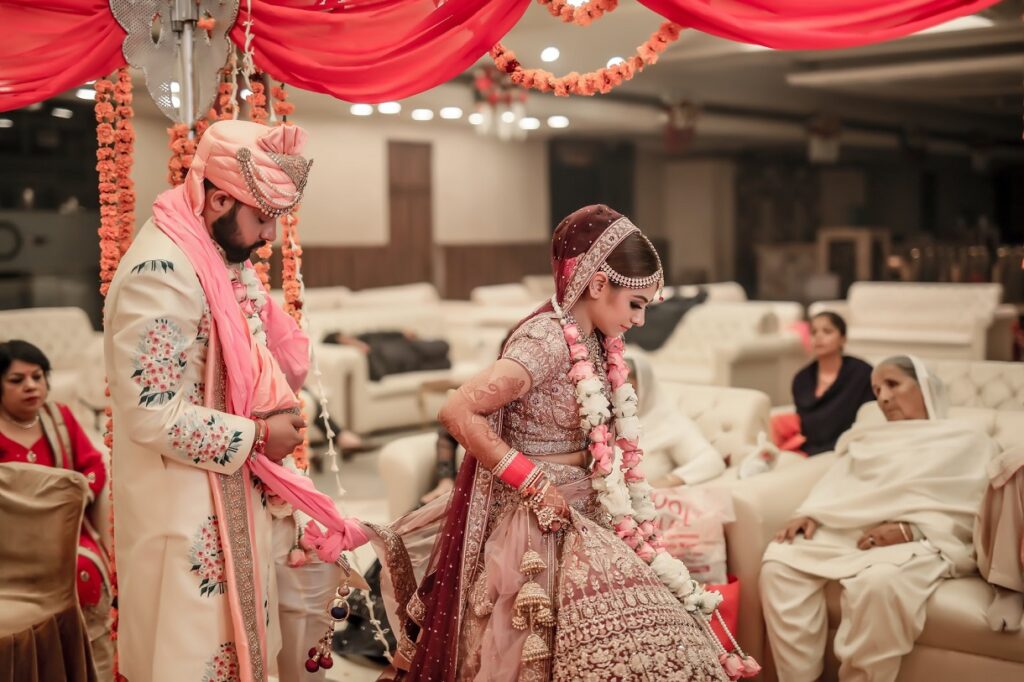In this article, we delve into the rich cultural and spiritual tapestry of Saptapadi, unraveling its meaning and the timeless wisdom it imparts to couples embarking on the sacred journey of marriage.

What does Saptapadi means?
Saptapadi, the sacred ritual of the Seven Steps or Saat Phere, is a venerable tradition deeply rooted in Indian weddings.
This ceremony, often referred to as ‘Saat Phere,’ holds profound significance in Hindu marital unions, symbolizing the journey of a couple through life’s various stages together. Each step represents a vow, a promise, and a shared commitment, forging an unbreakable bond between the bride and groom.
Did you know?
Although Saptapadi is a cherished tradition in South India, other regions, particularly North India, practice the ritual of Saat Pheras, which involves circling the sacred fire seven times. This act symbolizes the bond between a couple across seven lifetimes.
However, some believe there are no such thing as saat phera (seven circumambulations of the sacred fire) — this is an invention of Bollywood. This practice is only popular in some districts of North India and is never done in the South.
Grihya Sūtras – Four Rounds
The ancient texts, known as Grihya Sūtras, wedding rituals, yet there’s no explicit mention of Saat Phera or seven rounds. Some texts suggest four rounds, while others propose three.
The significance of the four rounds lies in reminding the couple of the four fundamental goals of human life:
Dharma: This pertains to ethical and moral duties towards one another, family, profession, and society. In certain rituals, the bride leads, symbolizing her role as the family’s moral compass and custodian of traditions.
Artha: Signifying material prosperity, the bride often leads in this aspect. According to Dharma Shastras, it is the husband’s duty to entrust his earnings and wealth to his wife, who manages the budget and financial matters.
Kāma: Representing enjoyment, pleasure, and procreation, the bride’s leadership reflects her role in managing these aspects.
These three factors collectively known as TRI-VARGA form the tripod of human happiness. Some manuals include the fourth goal, Moksha, which represents freedom. In weddings, it is typically led by the husband and signifies freedom from want, danger, and tribulations. However, the major Moksha, freedom from rebirth, is not mentioned during the wedding ceremony, as it conflicts with the householder state.
The central and most crucial aspect of the wedding ceremony is the SAPTA PADI, where the couple takes seven steps together. These steps symbolize the initial strides in their shared journey of life and each step represents a foundational block in constructing a perfect marriage.
Hence, in Gujarati weddings, the custom varies slightly as couples circle the fire only four times. This ritual aims to adhere to dharma (righteousness), seek artha (prosperity), embrace Kama (love), and ultimately attain moksha (spiritual liberation).
What are the 7 marriage vows and promises in indian weddings?
Indian wedding vows and promises vary based on cultural and regional traditions, but here are seven common vows that are often exchanged during Indian weddings:
Protection and Care: The groom vows to provide protection and care for his bride, promising to support and cherish her throughout their life journey.
Shared Responsibility: The couple promises to share responsibilities and make joint decisions for the well-being of their family and home.
Mutual Respect: They vow to treat each other with respect and honor, acknowledging each other’s individuality and valuing their partnership.
Support through Ups and Downs: The couple promises to stand by each other’s side through thick and thin. Supporting one another in times of joy, they also offer comfort and strength in moments of adversity.
Shared Goals and Growth: They vow to work together towards common goals, personal growth, and the betterment of their lives as well as their families.
Faithfulness: The couple pledges to remain faithful and loyal to each other, upholding the sanctity of their marital bond.
Unconditional Love: They promise to love each other unconditionally, embracing strengths and weaknesses. Together, they build a life filled with care, empathy, and affection.
These vows symbolize the couple’s commitment. They also reflect Indian culture’s values of unity, partnership, and mutual respect.
In the intricate tapestry of Indian wedding rituals, the significance of these rounds is not just in the rituals themselves. It lies in the profound symbolism they carry, be it four or seven rounds. The journey of marriage encompasses the ideals of dharma, artha, kāma, and, for some, the pursuit of Moksha.
These rounds, whether they number three or seven, symbolize shared responsibilities, joys, and marital aspirations. Each step is a reminder of the promises made, the commitments undertaken, and the journey embarked upon together.
The rituals differ by region and community, yet their purpose remains unchanged: forging a lasting and harmonious connection. These rituals symbolize the inception of a lifelong journey characterized by love, understanding, and mutual growth.

Stree Arogya is an energetic blog managed by five passionate women adept at managing work and family. Their collective knowledge covers women’s health, nutrition, fitness, mental well-being, and lifestyle tips. Through Stree Arogya, they inspire and educate readers, providing a wide array of insights for a balanced and satisfying life.



0 Comments